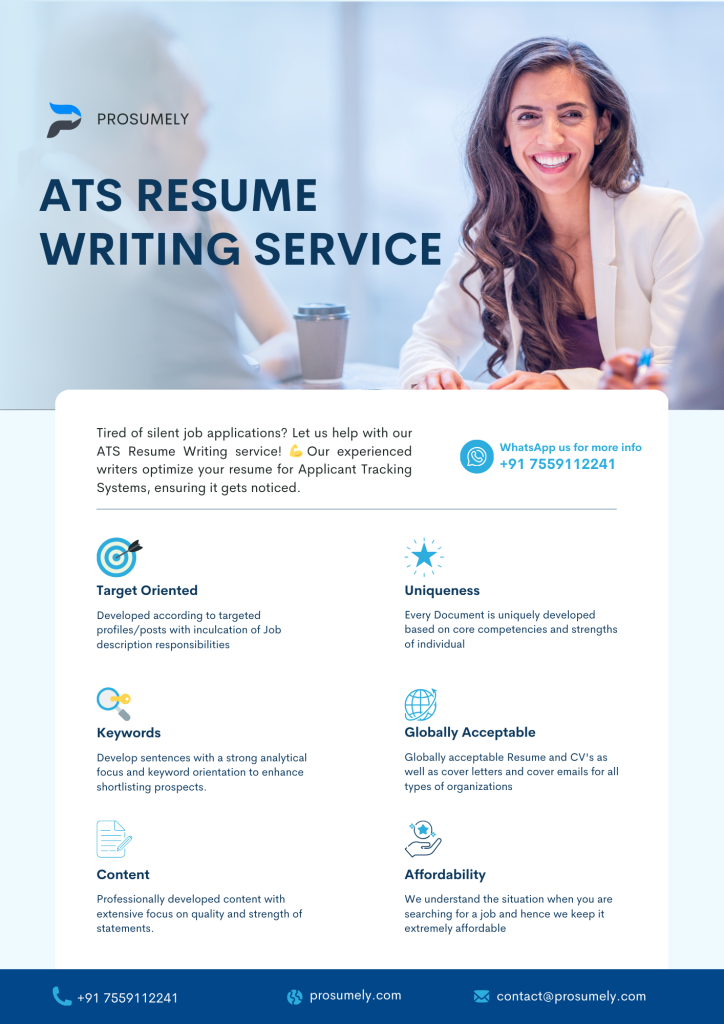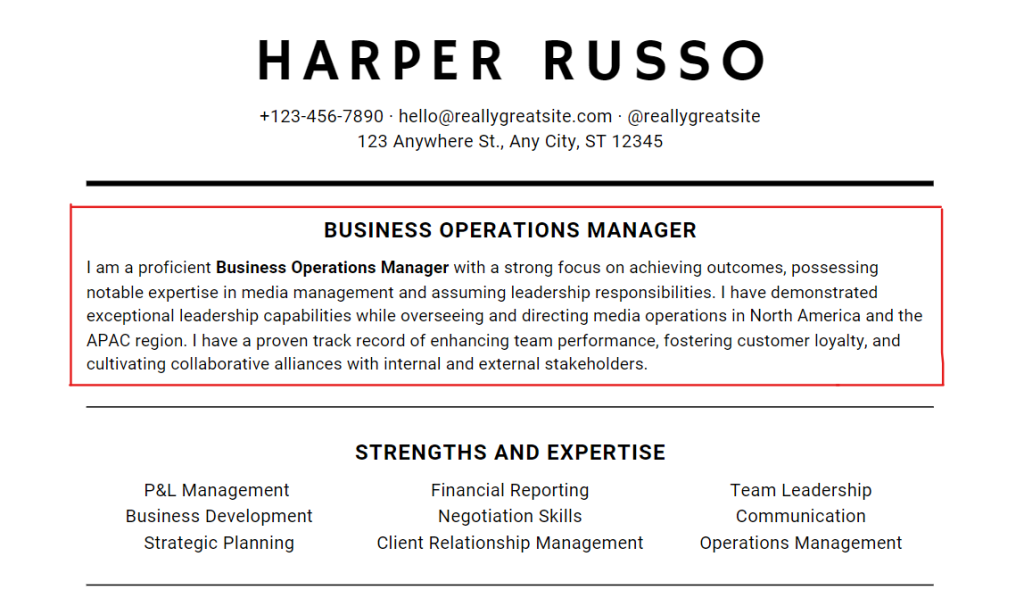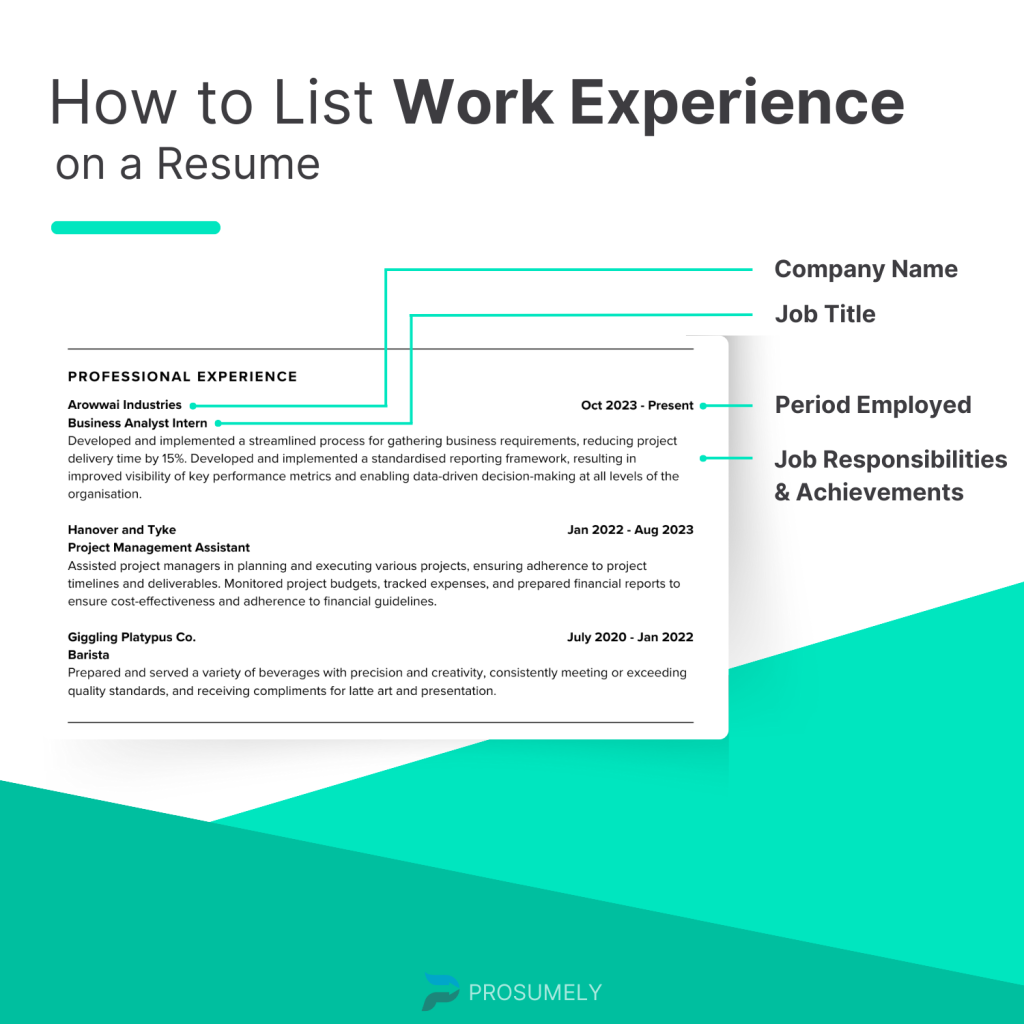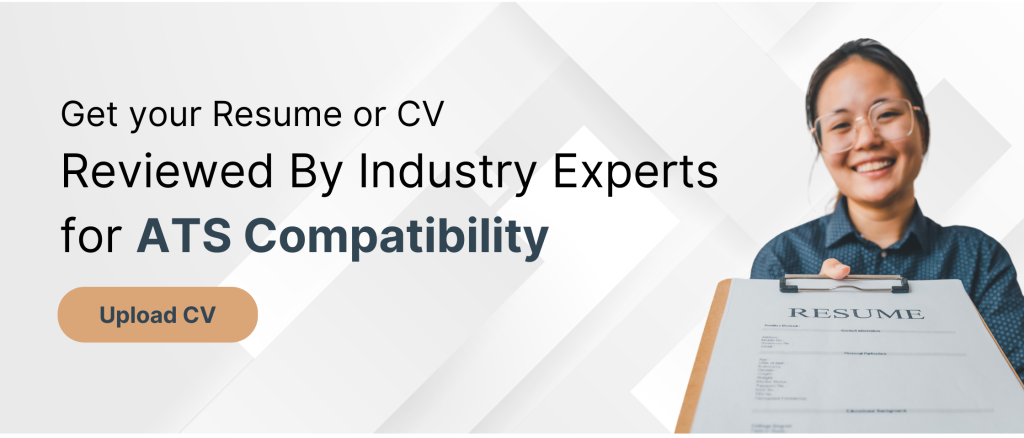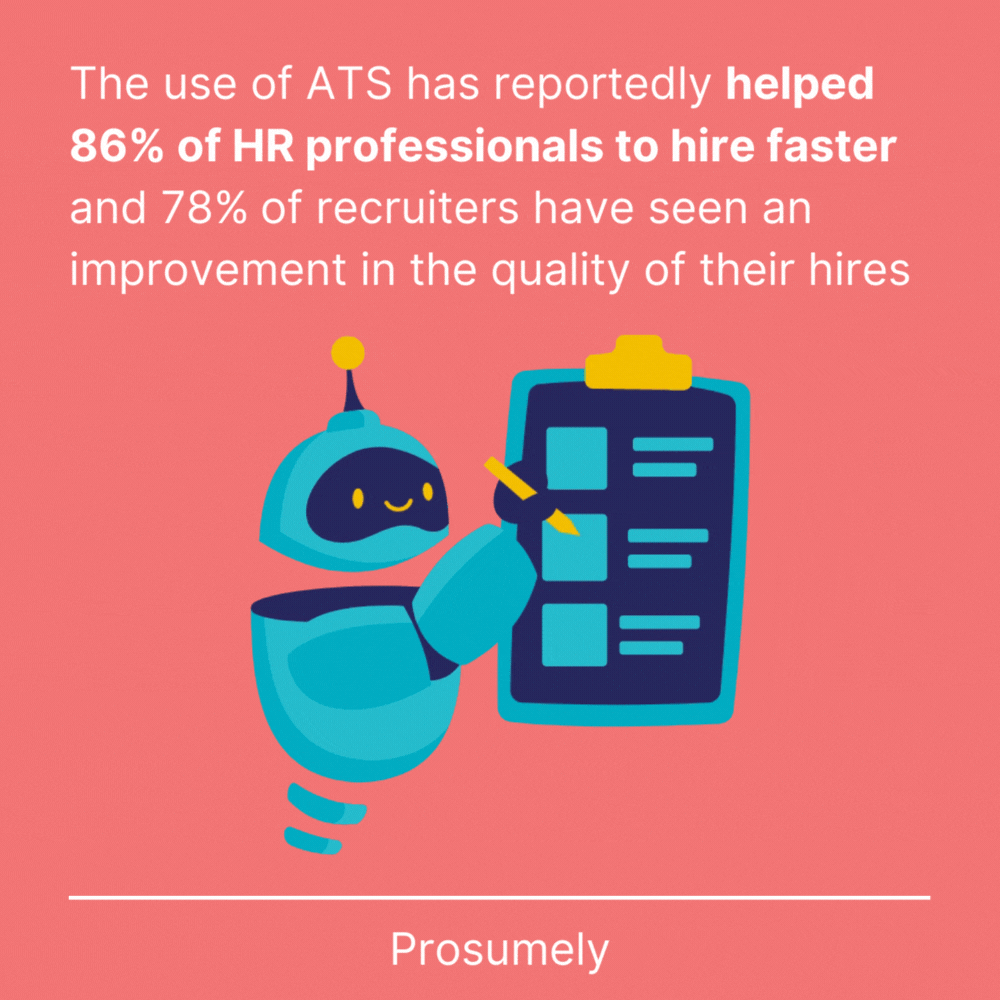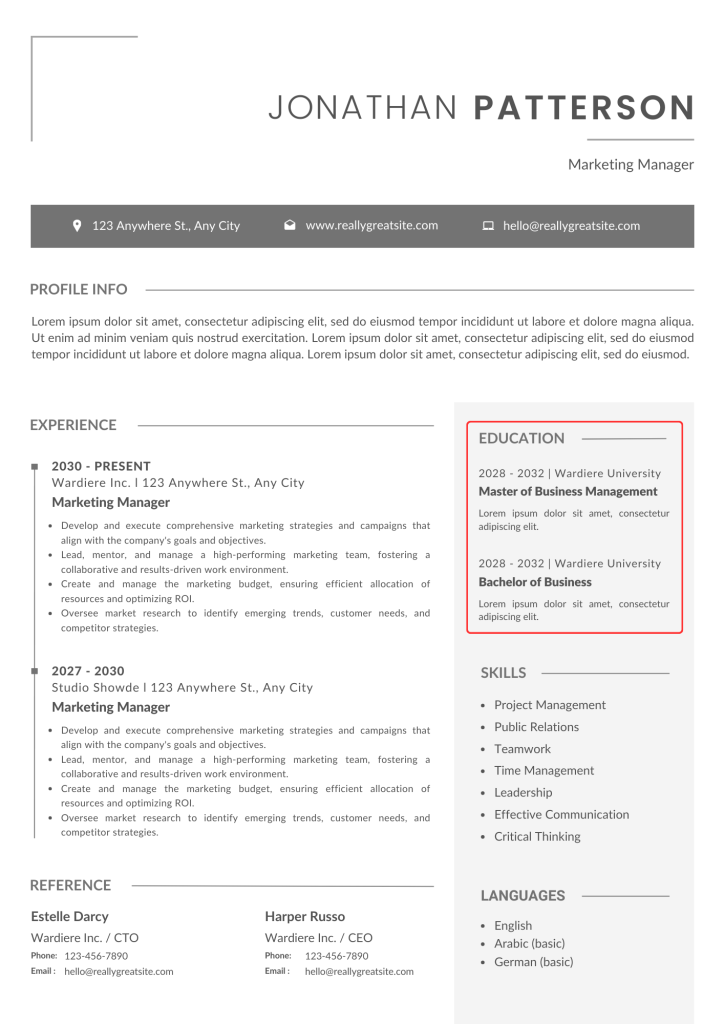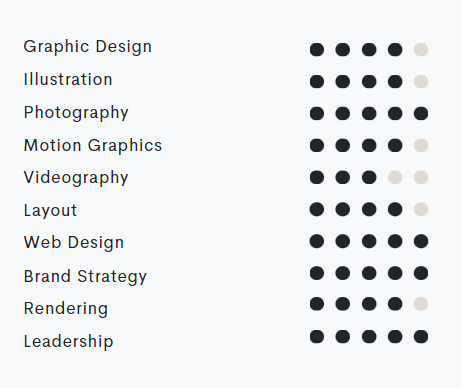How to Make a Resume in 2024 | Beginner's Guide

For the majority of those seeking employment, an effective resume is the barrier between their ideal role and option D. Perfecting your resume ensures responses from nearly every employer you reach out to.
However, if your resume is not up to par, you might find yourself waiting idly for weeks, or even months, without receiving a single reply.
Thus, you might be curious about crafting a resume that directly leads to interview invitations.
You’ve arrived at the perfect spot!
In this tutorial, we will cover all the essentials on crafting a standout resume, including:
- The 8 Crucial Steps for Resume Crafting
- Over 11 Unique Resume Tips for Enhancing Your Resume
- More than 27 Practical Resume Samples for Various Careers
…and much more!
Let’s jump right into it.
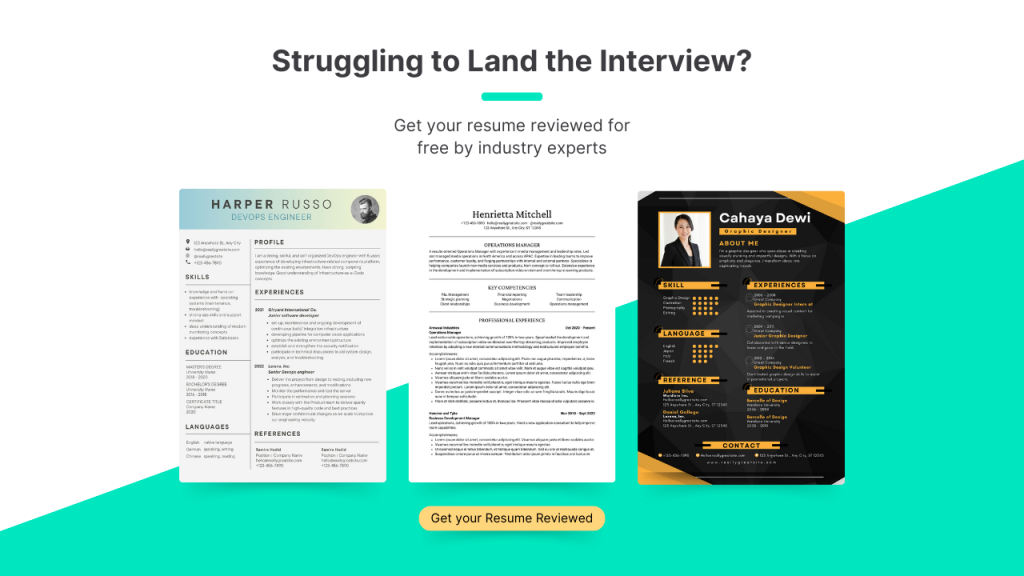
How to Make a Resume (The Right Way!)
Before diving into the specifics of resume creation, let’s overview the key steps and advice to remember:
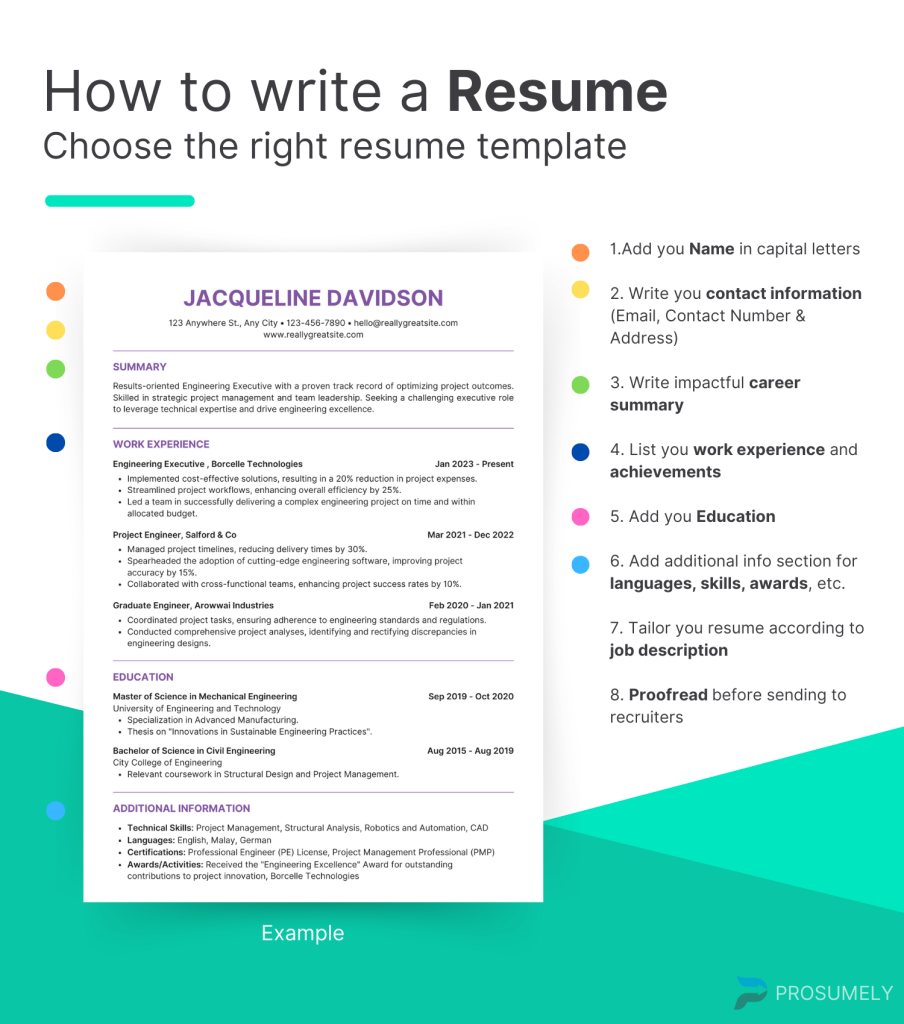
- Select your resume format with precision. For the vast majority, the reverse-chronological layout is the best choice.
- Ensure your contact information is correct and professional. Skip the photo and ensure your title, a professional email, and relevant online profiles (like LinkedIn, portfolio, or personal site) are included.
- Craft a compelling resume summary. For those beyond entry-level, a well-executed summary can persuade the hiring manager to review your entire resume.
- Enhance your work experience section. Elevate this section by aligning it with the job description, quantifying accomplishments, and incorporating action verbs and impactful words.
- Tailor your skills to the job. Focus on including both hard and soft skills essential for the role.
- Concise education details matter. Listing your highest or most recent degree suffices, unless you’re a new graduate with minimal work experience, then more detail may be beneficial.
- Utilize optional resume sections to stand out. Adding sections for languages, hobbies, certifications, or projects can differentiate you from candidates with similar qualifications.
- Don’t forget the cover letter. In 2024, cover letters are still vital, offering a chance to complement your resume with a well-written introduction. For guidance, see our comprehensive cover letter writing guide.
#1. Pick the Right Resume Format
Before diving into the content of your resume, prioritize its presentation. The initial aspect that catches the attention of recruiters is the appearance of your resume; content examination follows. Seize this opportunity to create a memorable first impression by selecting an appropriate resume layout.
Resume formats come in three main varieties:
- Reverse-chronological, the most widely accepted format, suits the majority of applicants due to its popularity across the globe.
- Functional, which highlights skills over professional history, is ideal for individuals at the onset of their careers or those with minimal experience in their field.
- Combination, best for candidates with extensive skills from varied backgrounds, fits those targeting positions requiring a broad range of expertise, showcasing the entirety of their capabilities.
Which format should you choose? For the vast majority, the reverse-chronological format is recommended. It aligns with recruiters’ expectations and is the standard in professional settings. This guide will concentrate on guiding you through crafting a reverse-chronological resume.
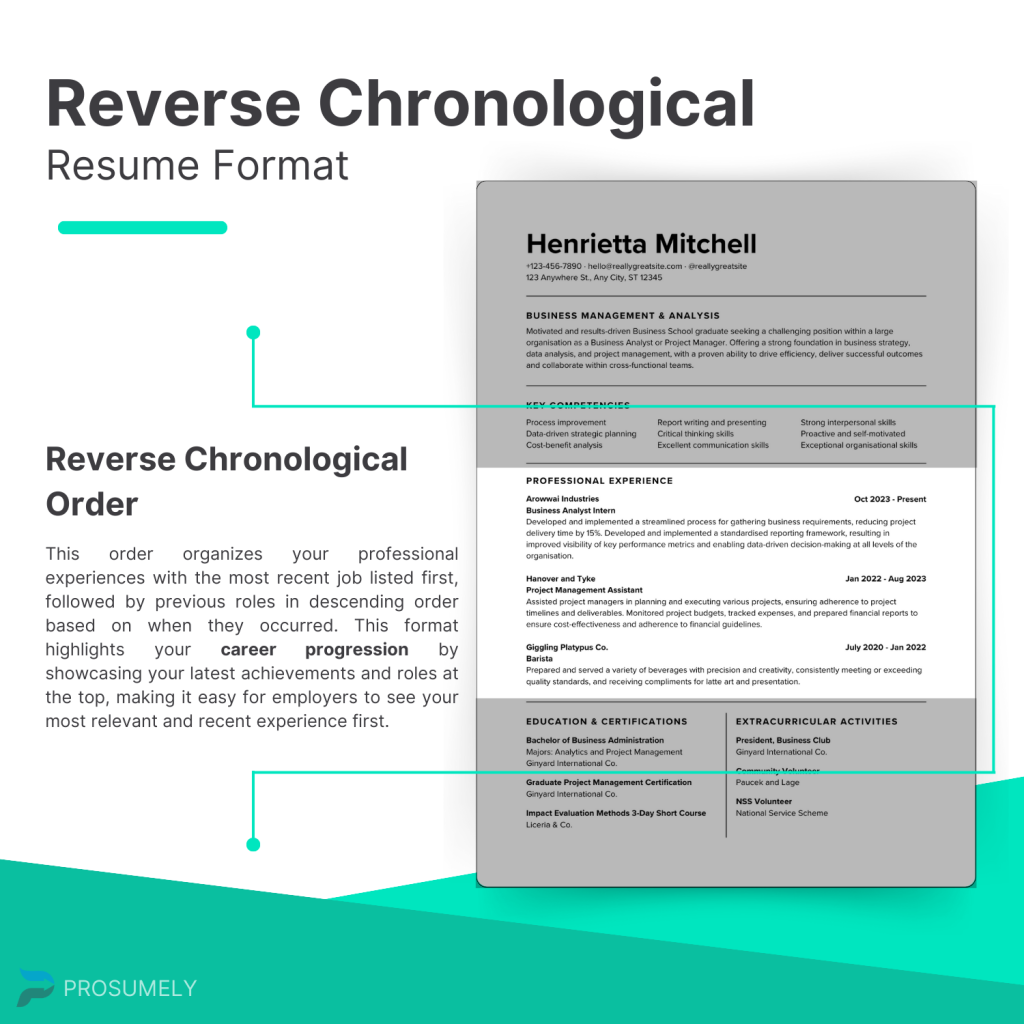
Fix Your Resume’s Layout
Once the format is established, let’s shift focus to the structure of your resume, which shapes its visual appeal.
Consider whether your resume appears tidy or disorganized, overly brief or excessively lengthy, mundane and easily overlooked, or engaging and compelling to the reader.
Here are essential guidelines to enhance your resume’s structure:
- Aim for a single-page resume unless extensive experience justifies a second page, understanding that recruiters, swamped with applications, prioritize brevity.
- Implement uniform section titles for effortless navigation, enhancing the recruiter’s ability to scan your resume.
Optimize margins to prevent a crowded appearance, ideally setting them to one inch on all sides for balanced whitespace. - Select a professional yet unique font to stand out, such as Ubuntu, Roboto, or Overpass, steering clear of overly common or informal choices like Times New Roman or Comic Sans.
- For readability, use a font size between 11-12 pt for body text and 14-16 pt for headings.
- Preferably save your resume as a PDF to preserve formatting, unless a different format is requested by the employer.
When deciding on your resume’s visual theme, weigh the merits of a conventional template against a more contemporary design:
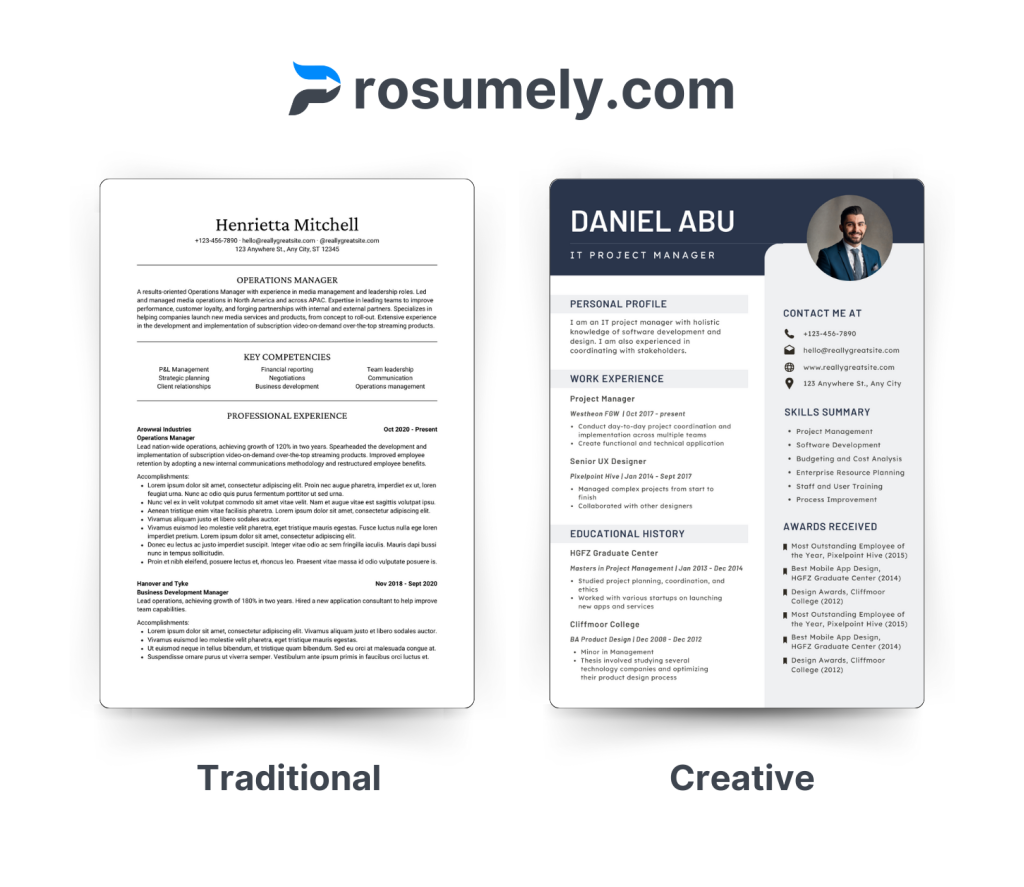
If your career path lies within a traditional sector such as law, banking, or finance, adhering to a classic resume template is advisable. These industries often favor formality and a straightforward approach to professional documentation.
Conversely, if your aspirations are aligned with the technology sector, where creativity and innovation hold significant value, opting for a more inventive resume template could be advantageous. In such fields, demonstrating your ability to think outside the box through your resume’s design can set you apart from other candidates.
Still Confused? Let our Experts Develop your Resume!
#2. Add Your Contact Information
With the formatting set, we now turn our attention to the essence of your resume—the content it presents.
Initiate the completion of your resume by incorporating your contact information.
This segment is straightforward yet vital. Position your contact details prominently at the top within a dedicated header, ensuring they are readily accessible to the hiring manager.
Accuracy in this section is non-negotiable. An impeccable resume loses its value if your email or phone number contains errors, preventing potential employers from reaching you. Such oversights could result in missed opportunities.
Therefore, it’s imperative to meticulously verify your contact information, ensuring its correctness and currency.
What to Include in Your Resume’s Contact Information Section:
Essential Details to Include:
- Full Name: Position your full name prominently at the beginning of your resume to catch attention.
- Email Address: Use a professional email, ideally comprising your first and last name for simplicity and professionalism (e.g., jane.doe@email.com).
- Phone Number: Ensure you list a current number where you are readily available for contact by the hiring manager.
- Location: Mention your city and state/country. If you’re open to relocation or seeking remote work, make this clear in your resume.
Additional Information You May Consider:
- Job Title: If applicable, place your current or most recent job title just below your name. Ensure it’s precise and reflects your role—avoid creative but unprofessional titles.
- LinkedIn Profile: Including a link to your LinkedIn profile is advisable as a vast majority of recruiters utilize this network for candidate assessment. LinkedIn makes up more than 50% of social traffic to B2B websites and blogs when shared on the platform
- Relevant Links: For professions where online portfolios or profiles are relevant, such as developers, designers, or marketers, include links to your professional websites or platforms like Github, Behance, or Dribbble.
What to Avoid in Your Resume’s Contact Information Section:
Things to Avoid on Your Resume:
- Date of Birth: Generally, there’s no need to include your date of birth unless the job advertisement specifically requests it. Including this information is unnecessary for the hiring decision and may inadvertently lead to age discrimination.
- Unprofessional Email Address: It’s time to retire that whimsical email from your teenage years. Opt for a professional email format, such as firstname.lastname@email.com, to convey a serious and professional image.
- Headshot: In countries like the USA, UK, or Ireland, including a photo on your resume can be inappropriate or even against hiring practices. While photos may be customary in resumes across many parts of Europe and Asia, it’s crucial to familiarize yourself with the norms and legalities of each specific country or industry you’re applying to.
Understood? Excellent! Let’s proceed to examine an exemplary layout of the contact information section on a resume:
#3. Write a Resume Headline (Summary or Objective)
It’s widely known that recruiters dedicate on average barely seven seconds to review a resume.
Given the overwhelming number of applications received daily, it’s understandably impractical to devote extensive time to each one.
Thus, to efficiently skim through resumes, hiring managers typically scan each one quickly, diving deeper only if something catches their eye.
This highlights the importance of the resume headline.
Positioned adjacent to or directly below your contact details, this concise paragraph is the initial content the hiring manager encounters on your resume.
Depending on your career stage, your resume headline may take the form of either a summary or an objective.
So, deciding between a resume summary and a resume objective? Here’s everything you need to understand:
Resume Summary
A resume summary, indicative by its title, offers a brief two to three-sentence overview of your professional journey. When crafted effectively, it instantly portrays you as a competent applicant, compelling the hiring manager to consider your application further.
Your resume summary ought to encompass:
- The position you hold and your professional tenure.
A selection of your most significant accomplishments or principal duties.
The skills most pertinent to the position you’re applying for.
Consider this template for an adeptly composed resume summary
Resume Summary Example
As an Android Developer with 5+ years of experience, I specialize in Java and Kotlin, with a strong grasp of Android SDK and architectural patterns like MVC, MVP, and MVVM. My portfolio includes a range of applications, from e-commerce to real-time messaging, showcasing my ability to leverage AR/VR, AI, and IoT technologies. Known for delivering high-quality solutions that enhance user engagement, I thrive in fast-paced settings, emphasizing collaboration, innovation, and problem-solving.
If you’re not a recent graduate or currently transitioning careers, a resume summary is typically the best choice for you. However, if you fall into either of these categories, considering a resume objective could be more advantageous.
Resume Objective
A resume objective aims to articulate your career ambitions, educational achievements, and any job-related skills you possess.
It highlights your enthusiasm for entering a new industry, making it ideal for recent graduates or individuals undergoing a career transition. Similar to a resume summary, it should be concise, ranging from two to four sentences.
Here’s an example for students:
Recent Graduate Resume Objective:
Eager to leverage my Computer Science degree and programming skills in Java, Python, and C++ within a dynamic tech environment. With a foundation in software development from academic projects and internships, I aim to contribute innovative solutions and grow my technical abilities at a forward-thinking company. Motivated to impact the technology field through problem-solving and teamwork.
Alternatively, for those transitioning into a new career path, it could be framed as follows:
Career Change Resume Objective:
Transitioning from a decade in customer service to the tech sector as a UX designer, I bring skills in communication, problem-solving, and leadership. Currently enhancing my UX skills through certification, I aim to contribute to innovative, user-centric digital products. My goal is to blend my service management experience with my passion for design and technology.
#4. Prioritize Your Work Experience
Your work experience section is the cornerstone of your resume.
It’s your opportunity to showcase your achievements and outline your past duties.
Mastering this segment is crucial to understanding the art of resume writing.
There are numerous best practices for detailing your work experience. However, before delving into the finer details, let’s begin with the fundamentals.
The conventional structure for listing each employment experience is as follows:
What to Include in Your Work Experience Section:
Include below points in your work experience:
- Position Held. Place your role at the forefront of each employment section. This ensures that a hiring manager immediately recognizes your relevant experience.
- Employer’s Name and Location. Include the company’s name along with its city and state or country. If the organization is not widely recognized, a brief description might be necessary.
- Period of Employment. Indicate the duration of your tenure with month and year, without needing to specify exact start and end dates.
- Key Accomplishments and Duties. The essence of your work experience lies here. Tailor this section to highlight significant achievements or responsibilities, pertinent to your industry, in bullet points for clarity and ease of reading.
Here’s a real-life example:
Always present your employment history in descending order (reverse chronological order), beginning with your latest position and moving backward in time.
With an understanding of how to organize your job history, we’ll guide you through the process of describing it in a manner that distinguishes you from other candidates, beginning with:
Focus on Achievements Whenever Possible
A frequent error on resumes is the mere cataloging of job duties in the work experience section.
Consider this – in many instances, the recruiter is already familiar with the typical tasks associated with your role.
Take, for instance, a sales manager. Expected duties might include:
- Initiating contact with prospective clients via phone or email.
- Sustaining and enhancing relationships with current clients, promoting relevant products.
- Monitoring and documenting lead progress in CRM systems.
Interestingly, these tasks are virtually identical for every sales manager, leading to a scenario where about 90% of resumes highlight similar responsibilities.
To differentiate yourself from other applicants, it’s more effective to emphasize your contributions and achievements on your resume. This could involve detailing how you contributed to your company’s growth, met or exceeded sales targets, etc.
Now, let’s examine the distinction between listing responsibilities and showcasing achievements for the identical position:
Correct Examples:
- Surpassed quarterly revenue targets by 15%, achieving $30,000 in sales.
- Orchestrated a marketing campaign that boosted lead conversion rates by 25%.
- Spearheaded a team initiative that reduced project turnaround time by 20%, enhancing overall productivity.
- Drove a customer satisfaction improvement strategy that raised service ratings by 35% within six months.
Wrong Examples:
- Called potential clients to introduce products.
- Oversaw client account management activities.
- Led team meetings and delegated tasks.
- Handled customer service inquiries and feedback.
It’s important to recognize that certain industries may not offer a plethora of quantifiable accomplishments. Consider the role of a warehouse operative, for example.
Typical tasks may involve:
- Daily loading, unloading, and arranging of equipment.
- Wrapping up products for dispatch.
- Helping with the opening and closing procedures of the warehouse.
In such sectors, it can be challenging to differentiate oneself based on achievements alone, making it acceptable to focus on responsibilities. Nevertheless, these responsibilities can be presented effectively by applying the additional tips we provide on detailing your work experience.
Consider Applicant Tracking System (ATS) Software
Around 75% of recruiters and hiring managers use some form of ATS software to facilitate their hiring processes, and this is even more prevalent among Fortune 500 companies, with 98% using ATS to find potential candidates
Nowadays, the majority of organizations rely on Applicant Tracking Systems (ATS) to analyze and sort through vast numbers of resumes quickly. These systems are set to filter out applications that fail to match the set requirements.
For instance, the absence of certain skills or non-compliance with the expected resume format can trigger an ATS to disqualify an application from the selection process.
Creating a resume that navigates through Applicant Tracking Systems (ATS) can be straightforward with the right approach.
Here are some strategies to enhance your resume’s ATS compatibility:
- Aim for brevity and relevance by maintaining your resume length to the commonly preferred one-page format, especially when job specifications indicate a length requirement. An overly extended resume may risk being automatically excluded.
- Embedding job-specific keywords into your resume is crucial. Scrutinize the job listing to identify the competencies and expertise the employer is seeking. Integrating these terms, especially in the context of your professional experiences and accomplishments, will align your resume more closely with the employer’s needs.
- Emphasize clarity and directness by employing an active voice to convey your professional experiences. For example, “Directed a sales team” is more concise and stronger than “Was in charge of a sales team.”
- Opt for dynamic verbs that convey leadership and initiative. Words like “orchestrated,” “championed,” or “executed” can make your resume stand out and portray your role in a proactive light, as opposed to more passive phrases like “was responsible for.”
These tips can significantly improve the likelihood that your resume will not only be recognized by an ATS but also demonstrate your qualifications effectively to potential employers.
#5. List Your Education
The upcoming part of your resume should focus on your educational background. Here’s a streamlined approach to structuring the education section:
Begin by listing your most recent educational achievement and proceed in reverse chronological order. Each entry should typically include the degree obtained, your field of study, the name of the institution, and the date of graduation. Depending on your level of professional experience, you may also include academic honors, scholarships, or relevant coursework.
Keep the formatting consistent and ensure it’s easy for potential employers to scan through your academic credentials.
What to Include in Your Resume’s Education Section:
Essential Details to Include
- Degree and Major: Clearly state your degree and major. (For example, “Bachelor of Science in Mechanical Engineering”)
- Institution: Include the name of the educational institution. (For example, “University of California, Berkeley”)
- Attendance Dates: Present the dates you were enrolled, using month/year format. (For example, “09/2016 – 05/2020”)
Additional Information You May Consider
- Location: If the school isn’t widely recognized, list its location. (For example, “Lund University, Lund, Sweden”)
- GPA: If applicable and impressive, list your GPA according to the local grading scale. (For example, “GPA: 3.8/4.0”)
- Honors: Mention any special academic recognitions. (For example, “Graduated with Honors”)
- Noteworthy Projects or Papers: Highlight any significant academic work. (For example, “Thesis on Renewable Energy Solutions”)
- Minor: If you pursued a minor, include it. (For example, “Minor in Environmental Science”)
This format ensures that potential employers or admissions committees can quickly assess your academic credentials and their relevance to your application.
#6. Emphasize Your Know-How in the Skills Section
Your capabilities and expertise are of prime interest to recruiters following your professional experience. In fact, your skills, in tandem with your work history, typically constitute the bulk of what influences a hiring manager’s decision, accounting for up to 90% of it.
This section is your opportunity to showcase the specific skills that qualify you as the ideal match for the position.
Skills are generally categorized into two types for resume writing:
- Technical Skills: These are quantifiable and teachable abilities that you’ve acquired through education or training. Examples might include expertise in software like Adobe Photoshop, proficiency in foreign languages, or technical skills like financial modeling.
- Interpersonal Skills: Often referred to as people or soft skills, these are less tangible and relate to how you interact with others and manage your work. They encompass abilities like communication, adaptability, problem-solving, and teamwork.
It’s crucial to balance both technical and interpersonal skills on your resume. For instance:
#7. Leverage Optional Resume Sections
The essential elements we’ve discussed are indeed the core components of any resume, functioning as the foundational pieces for any job application. Achieving proficiency in these areas significantly enhances your prospects of securing the positions you seek.
Should you find yourself with additional space, there are several supplementary sections you might consider to enrich your resume:
- Certifications or Awards: Detail any professional certifications, accolades, or recognitions that attest to your expertise or outstanding achievements in your field.
- Volunteer Work: Include relevant volunteer experiences that demonstrate transferable skills or a commitment to your community.
- Languages: List any additional languages you speak and your level of proficiency. This can be particularly advantageous in roles requiring multilingual communication.
- Hobbies and Interests: Share interests that are pertinent to the job or highlight unique skills and personal diversity.
- Publications or Presentations: Cite any relevant scholarly articles, books, or professional presentations that can underline your expertise and knowledge in the industry.
- Professional Memberships: Mention your affiliation with any professional organizations that enhance your network and indicate your active participation in your professional community.
These optional sections can offer a more comprehensive view of your capabilities and interests, potentially setting you apart from other candidates.
20 Expert Resume Tips
- Align Your LinkedIn Profile: Ensure your LinkedIn profile matches the information on your resume to maintain consistency across your professional presentation.
- Quantify Your Impact: Wherever possible, quantify your achievements with numbers, percentages, or tangible outcomes to provide clear evidence of your impact.
- Tailor Your Resume for Each Job: Customize your resume for each application based on the job description to highlight the most relevant experience and skills.
- Use a Professional Email Address: Ensure your contact email is professional, ideally based on your name, avoiding nicknames or outdated email providers.
- Incorporate Industry-Specific Jargon: Use terminology and acronyms common in your target industry to show your familiarity and expertise.
- Highlight Relevant Soft Skills: Besides technical skills, emphasize soft skills that are critical for the role, such as teamwork, leadership, or problem-solving.
- Include a Personal Brand Statement: Start your resume with a compelling summary or objective that encapsulates your professional identity and goals.
- Use Reverse Chronological Order: List your work experience and education in reverse chronological order to immediately show your most recent and relevant achievements.
- Optimize the Top Third of Your Resume: Make sure the top third of your resume is compelling and includes your most important qualifications and achievements.
- Limit Your Resume to Two Pages Maximum: Keep your resume concise and focused, ideally one page, but no more than two for those with extensive experience.
- Select a Readable Font: Use a professional, easy-to-read font like Arial, Calibri, or Times New Roman in a size between 10 and 12 points.
- Eliminate Outdated or Irrelevant Information: Remove old positions or details not relevant to the role you’re applying for to keep your resume focused.
- Showcase Your Career Progression: Demonstrate how you’ve advanced in your career by highlighting promotions and the increased level of responsibility over time.
- Mention Professional Development Courses: Include any relevant courses or certifications that demonstrate your commitment to continuous learning.
- Use Action Verbs: Start bullet points with action verbs like “developed,” “led,” or “increased” to clearly articulate your contributions.
- Avoid Common Buzzwords: Steer clear of overused terms like “hardworking” or “team player” without providing specific examples that illustrate these traits.
- Be Honest: Ensure that all the information on your resume is accurate and truthful to build trust with potential employers.
- Proofread Multiple Times: Carefully review your resume for grammatical errors or typos, as these mistakes can detract from your professionalism.
- Consider a Skills Section: If you have a wide range of relevant skills, consider adding a separate section to list them clearly.
- Seek Feedback: Before finalizing your resume, get feedback from mentors, colleagues, or professionals in your field to gain insights on how to improve.

